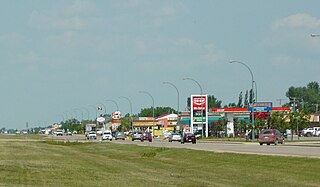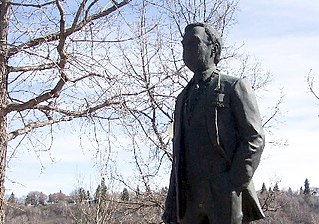The Saskatoon Provincial Correctional Centre is an adult male, provincial correctional centre located in Saskatoon, Saskatchewan, Canada. It is one of four provincial correctional centres in the province including the Regina Correctional Centre, the Prince Albert Correctional Centre and the only female institution, the Pine Grove Correctional Centre. The centre generally holds approximately 450 offenders, including those of the low security annex, the Saskatoon Urban Camp.
The centre holds alleged offenders that are currently awaiting trial (remanded) and those who are sentenced. As a provincial correctional centre, sentenced inmates serve a maximum of two years, less a day. Those who are sentenced to more than that are transferred to the Correctional Service of Canada (CSC). However, there are instances where federal inmates are sentenced to a provincial correctional centre, as the province of Saskatchewan has an exchange of services agreement with the CSC.
As all provincial offenders will be released into the community, the goal of the correctional system is to prepare offenders for a successful reintegration into the community. This is often done by offering a wide variety of programming including alcohol and drug programming, anger management, cognitive skills, psychological counseling, spiritual counseling and traditional aboriginal programming.

Saskatchewan is a prairie and boreal province in Canada, the only province without a natural border. It has an area of 651,900 square kilometres (251,700 sq mi), nearly 10 percent of which is fresh water, composed mostly of rivers, reservoirs, and the province's 100,000 lakes.

Prince Albert is the third-largest city in Saskatchewan, Canada, after Saskatoon and Regina. It is situated near the centre of the province on the banks of the North Saskatchewan River. The city is known as the "Gateway to the North" because it is the last major centre along the route to the resources of northern Saskatchewan. Prince Albert National Park is located 51 km (32 mi) north of the city and contains a huge wealth of lakes, forest, and wildlife. The city itself is located in a transition zone between the aspen parkland and boreal forest biomes. Prince Albert is bordered by the Rural Municipality of Prince Albert No. 461, of which it is the seat but remains politically independent, and the Rural Municipality of Buckland No. 491.

The Correctional Service of Canada, also known as Correctional Service Canada or Corrections Canada, is the Canadian federal government agency responsible for the incarceration and rehabilitation of convicted criminal offenders sentenced to two years or more. The agency has its headquarters in Ottawa, Ontario.
The Rotary Museum of Police and Corrections is a museum in Prince Albert, Saskatchewan, Canada. It covers the history of law enforcement in early Prince Albert and Saskatchewan.
The Gabriel Dumont Institute of Native Studies and Applied Research Inc. (GDI) was formally incorporated as a non-profit corporation in 1980, to serve the educational and cultural needs of the Saskatchewan Métis and Non-Status Indian community. The Institute is designated as the official education arm of the Métis Nation—Saskatchewan (MN-S). GDI offers a variety of accredited educational, vocational, and skills training opportunities for the province's Métis in partnership with the University of Regina, the University of Saskatchewan, the Saskatchewan Institute of Applied Science and Technology, the province's various regional colleges, and Service Canada.
Saskatchewan Penitentiary is a Medium Security Facility with Maximum Security areas. It is located on a walled 20-acre parcel of land in the Rural Municipality of Prince Albert No. 461, one kilometre west of Prince Albert, Saskatchewan, Canada. It opened in 1911 built on the site of a former residential school run by the Anglican Church of Canada.

Martensville is a city located in Saskatchewan, Canada, just 8 kilometres (5.0 mi) north of Saskatoon, and 14 kilometres (8.7 mi) southwest of Clarkboro Ferry which crosses the South Saskatchewan River. It is a bedroom community of Saskatoon. It is surrounded by the Rural Municipality of Corman Park No. 344. The community is served by the Saskatoon/Richter Field Aerodrome located immediately west of the city across Highway 12.

Highway 11 is a major north-south highway in Saskatchewan, Canada that connects the province's three largest cities: Regina, Saskatoon and Prince Albert. It is a structural pavement major arterial highway which is approximately 391 kilometres (243 mi) long. It is also known as the Louis Riel Trail (LRT) after the 19th century Métis leader. It runs from Highway 1 in Regina until Highway 2 south of Prince Albert. Historically the southern portion between Regina and Saskatoon was Provincial Highway 11, and followed the Dominion Survey lines on the square, and the northern portion between Saskatoon and Prince Albert was Provincial Highway 12.

Saskatoon is the most populous city in the Canadian province of Saskatchewan. Canada is a constitutional monarchy, and connections to the Crown in Saskatoon are visible in visits from the Sovereign, the Royal Family and vice-regal representatives, and also in the prominence of names and symbols in civic traditions. The Crown's image appears in the centrepiece portrait at Saskatoon City Council chamber and also in the badges of Saskatoon Police Service officers. On one of several visits to Saskatoon, the Queen said "Constitutional Monarchy has always placed the emphasis on people in community – as it were, a national family with the Sovereign as its head." Saskatoon's manifold connections include more than a dozen royal visits, frequent vice-regal visitors, namesakes for schools, streets and neighbourhoods, and the regular inclusion of its own namesake, the saskatoon berry, on menus for royal and vice-regal functions. Canada's definitive postage stamp features a photograph of the Queen taken in Saskatoon.
Culture of Saskatchewan views the patterns of human activity in the central prairie province of Canada examining the way people live in the geography, climate, and social context of Saskatchewan.
Saskatchewan Soccer Association (SSA) is the governing body for soccer in the Canadian province of Saskatchewan. The association was formed in 1905.
In Canada, the criminal legal system is divided into provincial/territorial and federal jurisdictions. Provincial/territorial facilities hold people on remand, who receive custody sentences of less than two years and people in immigration detention. Community sentences such as fines, community service work or probation are also under provincial/territorial jurisdiction. People who are sentenced to custody for two years or more are held in federal institutions. Youth criminal legal facilities and sentencing, including pre-trial supervision, community and custody sentences and Extrajudicial Sanctions Programs, are the responsibility of the provincial/territorial government.
There are numerous heritages and cultural attractions in the province of Saskatchewan. Museums, dinosaur digs, aboriginal cultural and heritage sites, art galleries, professional sport venues, spas, handcraft, antique and tea shops, agricultural tours, theatre and archaeological sites comprise over 600 varied Saskatchewan institutions.
A Gladue report is a type of pre-sentencing and bail hearing report that a Canadian court can request when considering sentencing an offender of Aboriginal background under Section 718.2(e) of the Criminal Code. Gladue was the first case to challenge section 718.2(e) of the criminal code
Ferndale Institution is the former name of the minimum-security federal correctional annex of Mission Institution, now referred as Mission Minimum Institution. Is located in Mission, British Columbia, in the central Fraser Valley, about 80 kilometres east of Vancouver. Ferndale opened in 1973 and can house up to 166 inmates, who live in residential-style units on a federal reserve shared with Mission Institution.
Nova Institution for Women is a Canadian federal prison for women in Truro, Nova Scotia. The facility, which handles different levels of offenders, can accommodate up to 70 inmates. Nova Institution opened in 1995. The maximum security unit opened in 2002 or 2003.
Incarceration in Canada is one of the main forms of punishment, rehabilitation, or both for the commission of an indictable offense and other offenses.
A healing lodge is a Canadian correctional institution designed to meet the needs of Aboriginal inmates. Healing lodges were created to address the concern that traditional prisons do not work on aboriginal offenders. Aboriginals are over-represented in the prison system and are also more likely to be the victims of crime. In healing lodges, the focus is on healing and reconnecting with indigenous culture while inmates serve their sentences. Connecting to nature, participating in cultural ceremonies, and learning spiritual teachings are how Healing Lodges process the rehabilitation and healing of inmates. They also have access to spiritual guidance from Elders and are encouraged to maintain connections with their families and communities. Healing lodges were proposed as an alternative for Aboriginal female offenders, but there are now healing lodges for Aboriginal male offenders as well. Women's healing lodges are minimum/medium-security facilities, and men's healing lodges are minimum-security facilities.






